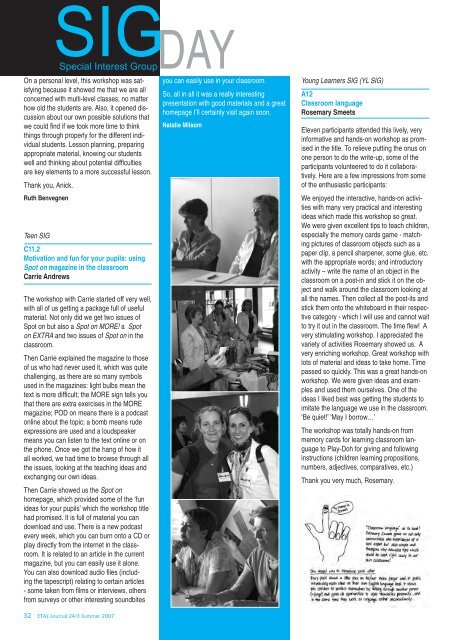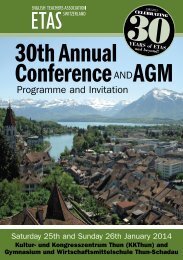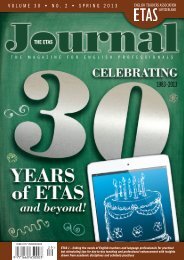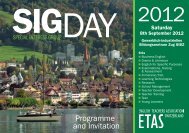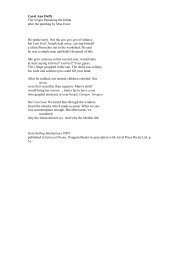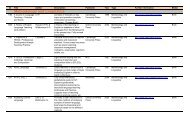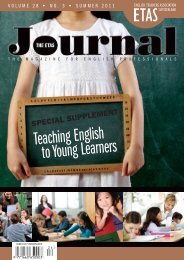The Magazine for English Professionals - English Teachers ...
The Magazine for English Professionals - English Teachers ...
The Magazine for English Professionals - English Teachers ...
Create successful ePaper yourself
Turn your PDF publications into a flip-book with our unique Google optimized e-Paper software.
SIGDAY<br />
Special Interest Group<br />
On a personal level, this workshop was satisfying<br />
because it showed me that we are all<br />
concerned with multi-level classes, no matter<br />
how old the students are. Also, it opened discussion<br />
about our own possible solutions that<br />
we could find if we took more time to think<br />
things through properly <strong>for</strong> the different individual<br />
students. Lesson planning, preparing<br />
appropriate material, knowing our students<br />
well and thinking about potential difficulties<br />
are key elements to a more successful lesson.<br />
Thank you, Anick.<br />
Ruth Benvegnen<br />
Teen SIG<br />
C11.2<br />
Motivation and fun <strong>for</strong> your pupils: using<br />
Spot on magazine in the classroom<br />
Carrie Andrews<br />
<strong>The</strong> workshop with Carrie started off very well,<br />
with all of us getting a package full of useful<br />
material. Not only did we get two issues of<br />
Spot on but also a Spot on MORE! a Spot<br />
on EXTRA and two issues of Spot on in the<br />
classroom.<br />
<strong>The</strong>n Carrie explained the magazine to those<br />
of us who had never used it, which was quite<br />
challenging, as there are so many symbols<br />
used in the magazines: light bulbs mean the<br />
text is more difficult; the MORE sign tells you<br />
that there are extra exercises in the MORE<br />
magazine; POD on means there is a podcast<br />
online about the topic; a bomb means rude<br />
expressions are used and a loudspeaker<br />
means you can listen to the text online or on<br />
the phone. Once we got the hang of how it<br />
all worked, we had time to browse through all<br />
the issues, looking at the teaching ideas and<br />
exchanging our own ideas.<br />
<strong>The</strong>n Carrie showed us the Spot on<br />
homepage, which provided some of the ‘fun<br />
ideas <strong>for</strong> your pupils’ which the workshop title<br />
had promised. It is full of material you can<br />
download and use. <strong>The</strong>re is a new podcast<br />
every week, which you can burn onto a CD or<br />
play directly from the internet in the classroom.<br />
It is related to an article in the current<br />
magazine, but you can easily use it alone.<br />
You can also download audio files (including<br />
the tapescript) relating to certain articles<br />
- some taken from films or interviews, others<br />
from surveys or other interesting soundbites<br />
32 ETAS Journal 24/3 Summer 2007<br />
you can easily use in your classroom.<br />
So, all in all it was a really interesting<br />
presentation with good materials and a great<br />
homepage I’ll certainly visit again soon.<br />
Natalie Milsom<br />
Young Learners SIG (YL SIG)<br />
A12<br />
Classroom language<br />
Rosemary Smeets<br />
Eleven participants attended this lively, very<br />
in<strong>for</strong>mative and hands-on workshop as promised<br />
in the title. To relieve putting the onus on<br />
one person to do the write-up, some of the<br />
participants volunteered to do it collaboratively.<br />
Here are a few impressions from some<br />
of the enthusiastic participants:<br />
We enjoyed the interactive, hands-on activities<br />
with many very practical and interesting<br />
ideas which made this workshop so great.<br />
We were given excellent tips to teach children,<br />
especially the memory cards game - matching<br />
pictures of classroom objects such as a<br />
paper clip, a pencil sharpener, some glue, etc.<br />
with the appropriate words; and introductory<br />
activity – write the name of an object in the<br />
classroom on a post-in and stick it on the object<br />
and walk around the classroom looking at<br />
all the names. <strong>The</strong>n collect all the post-its and<br />
stick them onto the whiteboard in their respective<br />
category - which I will use and cannot wait<br />
to try it out in the classroom. <strong>The</strong> time flew! A<br />
very stimulating workshop. I appreciated the<br />
variety of activities Rosemary showed us. A<br />
very enriching workshop. Great workshop with<br />
lots of material and ideas to take home. Time<br />
passed so quickly. This was a great hands-on<br />
workshop. We were given ideas and examples<br />
and used them ourselves. One of the<br />
ideas I liked best was getting the students to<br />
imitate the language we use in the classroom.<br />
‘Be quiet!’ ‘May I borrow…’<br />
<strong>The</strong> workshop was totally hands-on from<br />
memory cards <strong>for</strong> learning classroom language<br />
to Play-Doh <strong>for</strong> giving and following<br />
instructions (children learning propositions,<br />
numbers, adjectives, comparatives, etc.)<br />
Thank you very much, Rosemary.


